Holistic data protection
The Digital Personal Data Protection Act 2023 (DPDPA) signifies a revolutionary shift in India's data protection landscape. With the Information Technology Act 2000 serving as the precursor, the DPDPA promises a holistic framework to address the evolving challenges of data security.
Are you breaching your employees’ privacy?

Every organization has different privacy policies, but are you unwittingly being invasive?
- CCTV Monitoring: The extent of workplace surveillance needs to be addressed.
- Workplace Monitoring: Monitoring employee activities while balancing employee privacy is tricky.
- Background Screening: Delving into the nuances of pre-employment background checks is essential, but organizations should know where to draw the line.
- Social Media Monitoring: A balance between organizational interests and employee privacy on social media platforms must be highlighted.
- BYOD Policies: Is Bring Your Own Device the solution? We need to ask ourselves about the impact of employee data on the organization’s device.
- Profile Information: Scrutinizing the management and protection of employee profiles within organizational databases is the need of the hour.
Pre-DPDPA data protection regime for employers
In the pre-DPDPA era, employers navigated the Information Technology (Reasonable Security Practices and Procedures and Sensitive Personal Data or Information) Rules, 2011, with potential fines reaching up to INR 25,000.
Transitioning to the DPDPA
The DPDPA introduces a nuanced approach to processing employee data. While consent is not mandatory for routine employment activities, clarity is needed concerning data subjects and pre-employment processes.
The DPDPA allows a transitionary period for employers to continue the processing of personal data and employee data until consent is withdrawn. However, it mandates providing employees with a notice detailing the personal data being processed, the mechanism for exercising rights to delete personal data, and avenues for making complaints under the new regulatory framework.
Let’s understand the perspective this nuanced approach brings:

1. Consent Flexibility
Under the DPDPA, businesses cannot seek explicit consent for routine employment activities. This includes such exemptions as standard payroll management, performance assessments, and benefit administration. This departure from the conventional requirement streamlines day-to-day HR operations, offering practical advantages to employers.
2. Clarity on Pre-Employment Processes
Despite the relaxation of consent for routine activities, there remains a need for clarity regarding pre-employment processes. The DPDPA is not explicit about whether processing for "purposes of employment" includes pre-employment activities like shortlisting, interviews, or background checks. As the rules under the DPDPA are expected to provide more clarity, businesses are advised to stay abreast of developments to ensure compliance.
3. Data Processing for Safeguarding Employer Interests
The DPDPA permits the processing of employee data to safeguard the employer's interests, such as for national security, preventing corporate espionage or maintaining the confidentiality of trade secrets. This broader scope recognizes the multifaceted nature of data processing within the employment context, providing a more comprehensive framework for data subjects.
How to become a star employer?

There are certain obligations that employers must adhere to. This facilitates a healthy, symbiotic relationship between the employees and the employers.
1. Contractual Agreements with Data Processors
Processing by third-party data processors must align with valid contracts, emphasizing the importance of secure data handling throughout the ecosystem.
2. Security Measures
Employers must implement robust technical, organizational, and security measures to protect employee data, ensuring it is shielded from unauthorized access or data breaches.
3. Accuracy and Consistency
Ensuring the accuracy and consistency of employee data is paramount, especially when it influences decisions affecting employees.
4. Data Breach Notifications
In the event of a personal data breach, employers must promptly notify the Data Protection Board and affected individuals, highlighting the commitment to transparency.
5. Purpose Limitation
Personal data should only be processed for the specific purposes for which it was collected. Once the specified purpose of such processing is fulfilled, employers must take reasonable security safeguards to ensure data erasure in compliance with the DPDPA.
6. Grievance Redressal Mechanisms
Establishing effective mechanisms for addressing employee grievances related to data processing reinforces the commitment to fair and ethical data flows and data processor practices.
7. Rights for Data Principals
The DPDPA extends various rights to processing digital personal data principals, including the right to access, correct, and withdraw data collected without consent, emphasizing the empowerment of individuals over their digital personal data themselves.
8. Territorial Restrictions
Employers must ensure employee data is not transferred to restricted territories, private entities or countries, aligning with global data protection standards.
Practical steps for employers
1. Data Discovery and Mapping
- Employers are encouraged to conduct comprehensive data discovery and mapping exercises to understand the landscape of employee data processing. This involves identifying the data types, assessing processing purposes, and establishing a robust foundation for compliance.
2. Fortifying Documentation
- Reviewing and strengthening documentation, including employment agreements, internal policies, and frameworks, ensures they remain aligned with the DPDPA. This step is crucial for providing a legal basis for processing and maintaining compliance.
3. Vendor Assessments
- Revisiting agreements with service providers, including cloud providers, payroll processors, and insurers, becomes essential to ensure continued compliance. Seeking appropriate indemnifications from these providers adds an extra layer of protection.
4. Training and Sensitization
- Periodic training and awareness programs are vital for sensitizing employees to their rights, obligations, and the organization's commitment to data protection. This proactive approach fosters a culture of compliance from the ground level.
How can technology help you achieve data protection and compliance?
In the last section of this blog, we would like to cover the role of technology in aiding compliance.
1. Data Encryption Strategies
Employing robust encryption methods at the back end safeguards such personal data against unauthorized data access.
2. Role-Based Access Control
Implementing role-based and attribute-based access ensures data accessibility aligns with organizational hierarchies.
3. Data Classification and Retention Protocols
Clearly defined processes for data classification and retention facilitate seamless compliance adherence.






























.avif)






.avif)
.avif)





